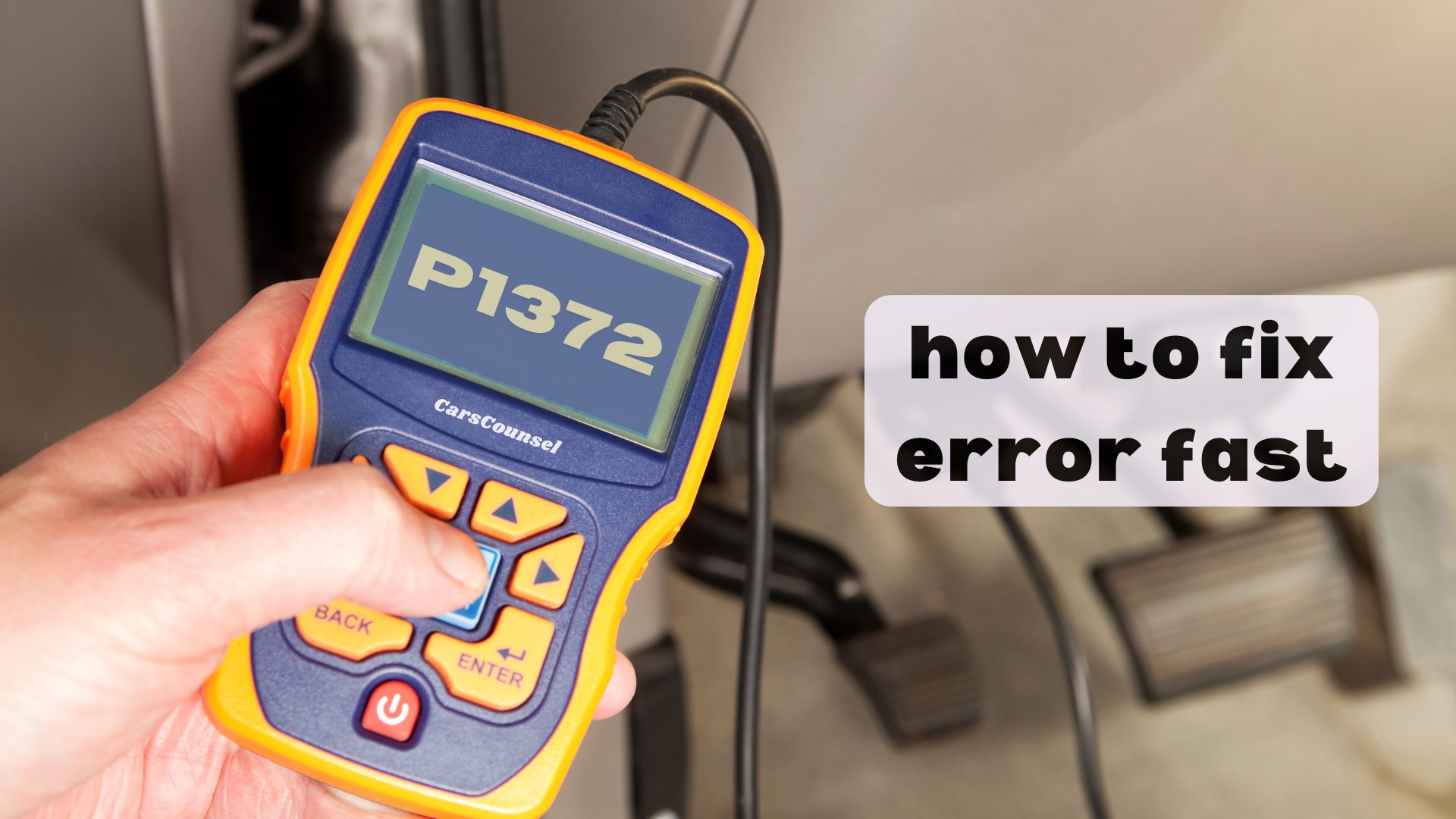If your car’s check engine light has come on and you’ve gotten a P1372 code, you’re likely wondering what’s going on. This error code indicates a problem with your crankshaft position sensor signal, which is a critical component of your engine’s operation.
Without a properly functioning sensor, your engine can experience rough idling, difficulty starting, and even stalling while driving. But what’s causing the malfunction, and how can you fix it?
Is it a faulty sensor, a wiring issue, or something more complex? You’ll need to get to the bottom of it to prevent further damage and get your car running smoothly again.

Quick Navigation
Key Takeaways
- The P1372 code indicates a malfunction in the crankshaft position sensor signal, affecting engine performance and potentially causing long-term damage.
- Common causes of the malfunction include sensor failure, wiring issues, engine timing belt or chain problems, and ECM software or hardware issues.
- Symptoms of the P1372 code include rough idling, difficulty starting the engine, reduced power and acceleration, and stalling or loss of power while driving.
- To diagnose the issue, use a scan tool to confirm the code, perform a visual inspection of the sensor and wiring, and test the sensor’s signal output with a multimeter.
- Proper repair involves addressing the underlying cause, cleaning or replacing the sensor, and recalibrating the signal output to ensure it’s within recommended specifications.
Code P1372 Definition
The P1372 code definition indicates a malfunction in the crankshaft position sensor signal, which is a pivotal component that monitors the position and speed of the crankshaft.
As you diagnose engine issues, understanding the importance of this sensor is paramount. The crankshaft position sensor provides essential information to the engine control module (ECM) for proper fuel delivery and ignition timing.
A malfunctioning sensor can lead to performance issues and potential long-term damage. When you encounter the P1372 code, it’s essential to address the issue promptly to prevent further complications.
In engine diagnosis, identifying the root cause of the malfunction is key to effective repairs.
Common Causes of Malfunction
When addressing the P1372 code, you’ll want to identify the root cause of the malfunction.
Sensor Failure is a common culprit, as a faulty crankshaft position sensor can’t provide accurate data to the engine control module (ECM). Wiring Issues are another possibility, as damaged or corroded wiring can disrupt the sensor signal.
Check the sensor circuit for any signs of wear or damage, and verify that the sensor is properly aligned and mounted. Other potential causes include engine timing belt or chain issues, as well as ECM software or hardware problems.
Identifying the Symptoms
As you’re dealing with a P1372 code, it’s essential to recognize the symptoms that led to this malfunction.
The crankshaft position sensor signal malfunction can significantly impact your engine’s performance, causing issues that you can’t ignore.
- Rough Idling: Your engine may stumble or hesitate, leading to poor engine performance.
- Difficulty Starting: You may struggle to start your engine, or it may take multiple attempts to get it running.
- Reduced Engine Power: Your vehicle’s acceleration and overall performance may be severely impacted.
- Stalling or Loss of Power: Your engine may stall or lose power while driving, which can be a serious safety concern.
Diagnostic and Repair Steps
Diagnosing the P1372 code requires a methodical approach to identify the root cause of the crankshaft position sensor signal malfunction.
You’ll need to use a scan tool to confirm the code and perform a visual inspection of the sensor and wiring. Look for signs of wear, corrosion, or damage that could be causing the sensor failure.
Check the sensor’s alignment and mounting to verify they’re correct. If you notice engine hesitation or other symptoms, it’s essential to address them promptly to prevent further damage.
Crankshaft Position Sensor Testing
Testing the crankshaft position sensor is a crucial step in identifying the root cause of the P1372 code.
You’ll need to verify the sensor’s signal output to determine if it’s functioning correctly.
- Perform a visual inspection of the sensor and wiring to check for signs of damage or corrosion.
- Clean the sensor to guarantee it’s free from debris or grime that might affect its performance.
- Use a multimeter to test the sensor’s signal output, certifying it’s within the recommended specifications.
- If necessary, perform signal calibration to guarantee the sensor is providing accurate data to the ECM.
Replacing the Faulty Sensor
Replacing a faulty crankshaft position sensor is a straightforward process that requires attention to detail and proper installation techniques. When selecting a replacement sensor, prioritize sensor quality to guarantee accurate signal transmission. Avoid cheap alternatives that may compromise performance or trigger future issues.
| Replacement Tips | Description |
|---|---|
| Verify sensor compatibility | Certify the new sensor matches the original specifications and vehicle make. |
| Clean the mounting area | Remove dirt and debris to prevent interference with the sensor’s magnetic field. |
| Secure proper alignment | Align the sensor correctly to prevent signal distortion or failure. |
| Inspect wiring and connectors | Check for damage or corrosion and repair or replace as needed.
Repair Cost and Estimate
When budgeting for repairs, it’s essential to get an accurate estimate for fixing the P1372 code.
The cost of repairing a crankshaft position sensor signal malfunction varies by vehicle make and model.
Here’s a breakdown of what you can expect:
- Parts cost: $50 to $200 for a replacement crankshaft position sensor.
- Labor cost: $100 to $300, depending on the mechanic’s hourly rate and the time required for the repair.
- Total cost: Typically falls within the range of $150 to $500.
- Warranty consideration: Check if your vehicle is still under warranty, as sensor replacement may be covered.
Remember to consult a qualified mechanic or repair shop for a precise estimate, as they can assess your vehicle’s specific needs.
Be sure to ask about any warranty options or potential discounts.
Troubleshooting and Prevention
To get to the root of the P1372 code, you’ll need to dig deeper and identify the underlying cause of the crankshaft position sensor signal malfunction.
Start by using a scan tool to confirm the code, then perform a visual inspection of the sensor and wiring to check for any signs of damage or wear.
Next, test the crankshaft position sensor using a multimeter to determine if it’s functioning properly.
Regular sensor maintenance is key to preventing issues like this.
Make sure to check your owner’s manual for recommended maintenance schedules to guarantee peak engine performance.
More OBD-II Codes
Frequently Asked Questions
Will a P1372 Code Cause My Car to Fail an Emissions Test?
When you take your car for an emissions test, a malfunctioning crankshaft position sensor can lead to failed results, as it affects engine performance, which in turn impacts emissions standards, making it likely to fail testing protocols.
Can I Drive My Car With a P1372 Code, or Is It Unsafe?
You can drive your car, but be cautious, as performance issues and engine stalling may occur, putting you and others at risk; it’s recommended to address the underlying issue to guarantee a safe and reliable driving experience, and to certify that your vehicle operates smoothly.
Will a Tune-Up or Oil Change Fix a P1372 Code?
You’re wondering if a tune-up or oil change will fix the issue, but unfortunately, it’s unlikely. Sensor cleaning might help, but if the problem persists, you’ll still experience engine stalling and poor performance, indicating a more serious issue requiring a deeper diagnosis and repair.
Can a Faulty Crankshaft Position Sensor Cause Other Codes?
You’ll find that a faulty crankshaft position sensor can trigger other codes, as its inaccuracy affects engine performance, potentially leading to stalling and misfires, which may set off codes related to fuel injection, ignition, or emissions systems.
Can I Replace the Crankshaft Position Sensor Myself, or Do I Need a Mechanic?
You can replace the crankshaft position sensor yourself, but be aware that accessing the sensor location can be tricky, and DIY challenges include proper alignment and wiring connections, so consider your mechanical skills before attempting the repair.
Conclusion
As you sit behind the wheel, the engine sputtering, the P1372 code flashing on your dashboard, you’re left wondering: what’s next? Will you be stranded on the side of the road, or will you make it home safely? The fate of your engine hangs in the balance, as you navigate the complex web of causes and symptoms. One thing’s for sure – ignoring the problem won’t make it disappear. The question is, will you take control, or let the malfunction take over?

